|
Mercedes CLS-class (W219)
Debut: 2004
Maker: Mercedes-Benz
Predecessor: no |
|
 Coupes
and roadsters are usually more profitable business than sedans. People
buy them out of emotion rather than practical reasons, so they are more
willing to pay extra money. That's why Mercedes-Benz has plenty of them
in its showrooms - C-class Sports Coupe, CLK-class, CL-class,
SLK-class,
SL-class and SLR. To squeeze another one into such an overcrowded
lineup
is really a headache. To prevent from internal competition, Mercedes
decided
to build a vastly different kind of vehicle - a 4-door coupe. You can
see
it as a crossover between sedan and coupe. It offers the practicality
of
regular sedans and the stylish look of coupes. This should fulfill the
dream of many people. Coupes
and roadsters are usually more profitable business than sedans. People
buy them out of emotion rather than practical reasons, so they are more
willing to pay extra money. That's why Mercedes-Benz has plenty of them
in its showrooms - C-class Sports Coupe, CLK-class, CL-class,
SLK-class,
SL-class and SLR. To squeeze another one into such an overcrowded
lineup
is really a headache. To prevent from internal competition, Mercedes
decided
to build a vastly different kind of vehicle - a 4-door coupe. You can
see
it as a crossover between sedan and coupe. It offers the practicality
of
regular sedans and the stylish look of coupes. This should fulfill the
dream of many people.
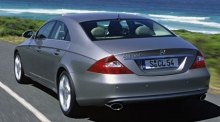 Mercedes
made no secret that the new CLS-class is derived from the E-class
platform.
Sharing all mechanicals (but with different tuning) and even the same
wheelbase,
CLS is virtually an E-class in coupe shape. But from outside it looks
nothing
in common with the E-class. Look at that curvy body! that dramatic,
banana-shaped
waistline! Mercedes' styling has never been so radical. That said, it
is
a controversial design. Some people love it and some people hate
it. Mercedes
made no secret that the new CLS-class is derived from the E-class
platform.
Sharing all mechanicals (but with different tuning) and even the same
wheelbase,
CLS is virtually an E-class in coupe shape. But from outside it looks
nothing
in common with the E-class. Look at that curvy body! that dramatic,
banana-shaped
waistline! Mercedes' styling has never been so radical. That said, it
is
a controversial design. Some people love it and some people hate
it.
The
CLS body is
95mm longer,
51mm wider and 27mm lower than its sedan sister. Surprisingly, it is
actually
less aerodynamic efficient, as drag coefficient is 0.30, versus the
sedan's
0.27. It also carries 50-85kg more than the sedan, so it is actually
slower
than the E-class with equivalent engines.
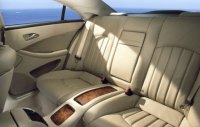 Inside,
the driver sacrifices 37mm headroom, the rear passengers lose similar
headroom
and legroom - the latter is reduced because the seats are moved forward
to prevent the passenger's heads from touching the sloping roof. The
CLS
also lost the middle rear seat because its inward-curved side windows
and
roof rails eat into cabin room. The middle seat is replaced by a
storage
box and the outer seats are moved inward. CLS is therefore a strict
4-seater. Inside,
the driver sacrifices 37mm headroom, the rear passengers lose similar
headroom
and legroom - the latter is reduced because the seats are moved forward
to prevent the passenger's heads from touching the sloping roof. The
CLS
also lost the middle rear seat because its inward-curved side windows
and
roof rails eat into cabin room. The middle seat is replaced by a
storage
box and the outer seats are moved inward. CLS is therefore a strict
4-seater.
With all these
disadvantages,
CLS still dare to ask for a price 10% in excess of the E-class. Isn't
it
crazy?
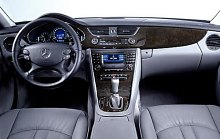 Not
exactly. Apart from the look, the CLS offers a couple of important
advances
over E-class. The first one is a high-quality cabin. In the recent SLK
and A-class we already saw a revival of cabin quality, but they are
plastic
one. Unlike them, the CLS cabin is thoroughly trimmed with expensive
leather
and wood in the way like British prestige cars. The main dashboard is a
single piece of wood, surrounded by soft leather trimming, chromed
dials
and vents. The high precision of fit and finish can be seen in the
tight
panel gaps - this is especially difficult to achieve for a high
curvature
architecture like this. Undoubtedly, the CLS cabin sets new standard
for
Mercedes' cabin quality. Not
exactly. Apart from the look, the CLS offers a couple of important
advances
over E-class. The first one is a high-quality cabin. In the recent SLK
and A-class we already saw a revival of cabin quality, but they are
plastic
one. Unlike them, the CLS cabin is thoroughly trimmed with expensive
leather
and wood in the way like British prestige cars. The main dashboard is a
single piece of wood, surrounded by soft leather trimming, chromed
dials
and vents. The high precision of fit and finish can be seen in the
tight
panel gaps - this is especially difficult to achieve for a high
curvature
architecture like this. Undoubtedly, the CLS cabin sets new standard
for
Mercedes' cabin quality.
Another
advance
over the
E-class is the sportier chassis tuning. A 10% quicker steering rack
feels
instantly sharper and more accurate (it will be introduced to the
E-class
later). The change is simple, but the result is a lot more enjoyable
than
the old system. No matter with or without Airmatic DC, stiffer
suspension
setup improves the car's reaction to steering input. The setting is
well
judged to achieve a great balance between sporty and comfort, thus the
E-class' remarkable ride quality and quietness are mostly
retained.
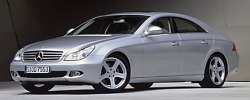 CLS
is no lightweight, fortunately it gets some strong engines. CLS350 uses
the company's new 3.5-ltire V6 with 24 valves and variable valve
timing.
Delivering 272 horsepower, it takes less than 7 seconds to accelerate
from
0 to 60mph. CLS500 runs the long-serving 306hp 3-valve-per-cylinder V8.
It is actually not much quicker than CLS350. Expect a new 4-valve V8
will
replace it in a year's time. The AMG version is powered by the familiar
476hp supercharged V8 like E55. It will be discussed in a separate
report. CLS
is no lightweight, fortunately it gets some strong engines. CLS350 uses
the company's new 3.5-ltire V6 with 24 valves and variable valve
timing.
Delivering 272 horsepower, it takes less than 7 seconds to accelerate
from
0 to 60mph. CLS500 runs the long-serving 306hp 3-valve-per-cylinder V8.
It is actually not much quicker than CLS350. Expect a new 4-valve V8
will
replace it in a year's time. The AMG version is powered by the familiar
476hp supercharged V8 like E55. It will be discussed in a separate
report.
Both
CLS350 and
CLS500 are
benefited by the new 7-speed automatic transmission. These powertrain /
drivetrain combo are creamy smooth.
With
a new-found
sportier
character, CLS has the ability to lure buyers from the BMW camp.
Simultaneously,
being luxuriously-crafted, smooth and refined, it is also a true
Mercedes-Benz. |
| The
above report was last updated on 19 Jan
2005. All Rights Reserved. |
CLS55 AMG
|
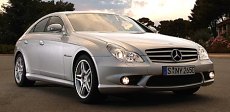 To
save me hundreds of words, please read my E55 report first. To
save me hundreds of words, please read my E55 report first.
Now
I suppose you
have read
it. Basically, CLS55 AMG received the same treatment as its sedan
counterpart.
The same 476 horsepower supercharged 5.4 V8 drives through a 5-speed
automatic
gearbox - unfortunately Mercedes' new 7-speed auto is not yet strong
enough
for this application, but the AMG-programmed 5-speeder shifts quicker
than
the regular one. CLS55 has as much as 516 pound-foot of torque to light
up the rear tires. Although it is 85kg heaver than E55, Mercedes still
believes it can storm from zero to sixth miles per hour in 4.6 seconds.
That's more than capable to destroy the confidence of those 911 drivers
encountered in Autobahn.
Compare with
regular CLS,
the AMG version has its Airmatic DC suspensions dropped by 10mm to
lower
center of gravity. At the same time, the suspension calibration becomes
stiffer, more capable of resisting body roll. 255/40 front and 285/35
rear
tires provides abundance of grip.
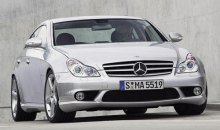 On
the road, CLS55 feels vastly different from E55. We are not talking
about
the performance loss, which is too small to be mentioned. The
difference
start from the driver's vision. He sits lower in the chassis, much
deeper
than the high shoulder line. Visibility is fairly confined. Such
driving
environment feels like that of a sports car. On
the road, CLS55 feels vastly different from E55. We are not talking
about
the performance loss, which is too small to be mentioned. The
difference
start from the driver's vision. He sits lower in the chassis, much
deeper
than the high shoulder line. Visibility is fairly confined. Such
driving
environment feels like that of a sports car.
Steer
the CLS55
into a bend
and you will realize its quicker steering response and higher accuracy,
thanks to the new steering rack that shared with other CLS. The tauter
suspension also contain body roll better. As a driver's car, CLS55 is
definitely
better than E55.
But better
than
E55 is not
enough. The question is can it beat BMW M5, the current King of Sports
Sedans?
CLS55 AMG
versus BMW M5
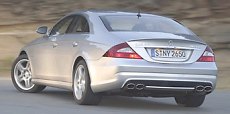 Autocar
magazine compared the two cars and found them a close match. The AMG
has
a deficit of 30 horsepower and a weight penalty of 90kg, but in normal
circumstances it is just as fast, because its supercharged V8 is super
torquey and its power is easily accessible. In contrast, the BMW V10
needs
sky-high rpm to deliver the same level of performance. This means M5 is
noisier and more demanding to drive. In attack mode, its SMG
semi-automatic
gearbox sends shocks to the cabin in every gearchange. The stiff ride
is
also harsher than the AMG. In contrast, CLS55 delivers performance in a
much calmer and smoother style. Its engine is quieter, its automatic
transmission
is super-smooth, and its adaptive air suspensions isolate shocks way
better. Autocar
magazine compared the two cars and found them a close match. The AMG
has
a deficit of 30 horsepower and a weight penalty of 90kg, but in normal
circumstances it is just as fast, because its supercharged V8 is super
torquey and its power is easily accessible. In contrast, the BMW V10
needs
sky-high rpm to deliver the same level of performance. This means M5 is
noisier and more demanding to drive. In attack mode, its SMG
semi-automatic
gearbox sends shocks to the cabin in every gearchange. The stiff ride
is
also harsher than the AMG. In contrast, CLS55 delivers performance in a
much calmer and smoother style. Its engine is quieter, its automatic
transmission
is super-smooth, and its adaptive air suspensions isolate shocks way
better.
The
BMW has no
much advantage
in handling either. Both cars display remarkable stability at high
speed.
Both cars have quick and accurate steering. Surprisingly, after
switched
off traction control, the AMG can power slide in the same way as M5,
giving
its driver the same confidence. But ultimately the BMW can corner
faster,
harder and more neutrally. The AMG's softer suspensions and tendency to
understeer rob it of an ultimate win.
At
eight-tenth
effort, CLS55
is a better performance car than the M5. In contrast, when you want to
deliver maximum ability, the M5 will be the better choice.
|
| The
above report was last updated on 19 Jan
2005. All Rights Reserved. |
CLS63 AMG
|
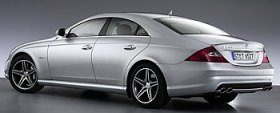 We
have reported the new AMG 6.3 engine already in the top CLK and
E-class, so this time not going to spend too much time on the engine.
In short, the naturally aspirated V8 combines good power, torque and
efficiency rarely appeared simultaneously on a large-capacity V8. As in
E-class, it produces 514 horsepower at 6800 rpm and 465 lbft at 5200
rpm in CLS63. That added a little horsepower but loses some torque from
the outgoing 5.5-litre supercharged V8. Part of the lost torque is
compensated by the responsive new 7-speed automatic gearbox, but you
can still feel the engine is not as strong at bottom end. Of course,
everything is relative. If you compare with a BMW M5, you will find the
AMG V8 is hugely flexible. If you compare with the old engine, you will
praise its smoothness, throttle response and the ability to rev cleanly
to 7200 rpm. So, while the performance is virtually unchanged –
depending on whether you believe AMG's claims that it reduces 0-60 mph
from 4.6 to 4.4 seconds – the new engine is definitely sweeter. We
have reported the new AMG 6.3 engine already in the top CLK and
E-class, so this time not going to spend too much time on the engine.
In short, the naturally aspirated V8 combines good power, torque and
efficiency rarely appeared simultaneously on a large-capacity V8. As in
E-class, it produces 514 horsepower at 6800 rpm and 465 lbft at 5200
rpm in CLS63. That added a little horsepower but loses some torque from
the outgoing 5.5-litre supercharged V8. Part of the lost torque is
compensated by the responsive new 7-speed automatic gearbox, but you
can still feel the engine is not as strong at bottom end. Of course,
everything is relative. If you compare with a BMW M5, you will find the
AMG V8 is hugely flexible. If you compare with the old engine, you will
praise its smoothness, throttle response and the ability to rev cleanly
to 7200 rpm. So, while the performance is virtually unchanged –
depending on whether you believe AMG's claims that it reduces 0-60 mph
from 4.6 to 4.4 seconds – the new engine is definitely sweeter.
There are not much changes to the chassis, but we all know the original
CLS55 was already better than its E-class cousin. Thanks to the lower
center of gravity brought by the lower roof and lower ride height, in
addition to the quicker and meatier steering, the CLS delights
keen drivers as much as BMW M5 yet without its hard-edge ride. The
Airmatic DC suspensions provide incredibly smooth ride for this
performance level.
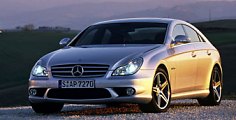 The
biggest improvement to the chassis is braking. Ditching the troublesome
SBC electronic brakes, it gets a conventional set of hydraulic brakes
with cross-drilled discs measuring 360mm up front and 340mm at the
rear. The front discs are even made of ceramic composites. The new
braking system brings a much more progressive, natural and feelsome
pedal action. The
biggest improvement to the chassis is braking. Ditching the troublesome
SBC electronic brakes, it gets a conventional set of hydraulic brakes
with cross-drilled discs measuring 360mm up front and 340mm at the
rear. The front discs are even made of ceramic composites. The new
braking system brings a much more progressive, natural and feelsome
pedal action.
With better brakes, quicker transmission and an eager new V8, CLS63
seems capable of beating M5 as the best performance saloon, provided
you classify it as a saloon instead of 4-door coupe. Of course, before
they encounter we won't know who is going to be the ultimate winner.
|
| The
above report was last updated on 7 Aug 2006. All
Rights Reserved. |
|
|
|
General remarks
|
CLS350
|
CLS500
|
CLS55 AMG
|
Layout
|
Front-engined, RWD
|
Front-engined, RWD
|
Front-engined, RWD |
Chassis
|
Steel monocoque
|
Steel monocoque |
Steel monocoque |
Body
|
Mainly steel
|
Mainly steel |
Mainly steel |
| Length / width / height |
4913 / 1873
/ 1403 mm |
4913 / 1873
/ 1403 mm |
4913 / 1873
/ 1389 mm |
| Wheelbase |
2854 mm |
2854 mm |
2854 mm |
Engine
|
V6, 90-degree
|
V8, 90-degree
|
V8, 90-degree |
Capacity
|
3498 cc
|
4966 cc |
5439 cc
|
Valve gears
|
DOHC 24 valves, VVT
|
SOHC 24 valves, VVT |
SOHC 24 valves, VVT |
Induction
|
VIM
|
VIM |
Supercharger
|
Other engine features
|
-
|
Twin-spark
|
Twin-spark |
Max power
|
272 hp |
306 hp |
476 hp
|
Max torque
|
258 lbft |
339 lbft |
516 lbft
|
Transmission
|
7-speed automatic
|
7-speed automatic
|
5-speed automatic
|
Suspension layout
|
F: 4-link
R: multi-link
|
F: 4-link
R: multi-link |
F: 4-link
R: multi-link |
Suspension features
|
-
|
Adaptive air spring + damping
|
Adaptive air spring + damping |
Tyres front/rear
|
245/45ZR17
|
245/40ZR18
|
F: 255/40ZR18
R: 285/35ZR18 |
Kerb weight
|
1655 kg
|
1735 kg
|
1845 kg
|
Top speed
|
155 mph (limited) |
155 mph (limited)
|
155 mph (limited) |
0-60 mph (sec)
|
6.7 (c)
|
5.5* / 5.8**
|
4.6 (c) / 4.2*
|
0-100 mph (sec)
|
-
|
14.0* / 14.5**
|
9.7*
|
| Performance
tested by: |
*C&D,
**Autocar |
|
CLS350 CGI (2006)
|
CLS500 (2006)
|
CLS63 AMG (2006)
|
Layout
|
Front-engined, RWD
|
Front-engined, RWD
|
Front-engined, RWD |
Chassis
|
Steel monocoque
|
Steel monocoque |
Steel monocoque |
Body
|
Mainly steel
|
Mainly steel |
Mainly steel |
| Length / width / height |
4913 / 1873
/ 1403 mm |
4913 / 1873
/ 1403 mm |
4915 / 1873
/ 1389 mm |
| Wheelbase |
2854 mm |
2854 mm |
2854 mm |
Engine
|
V6, 90-degree
|
V8, 90-degree
|
V8, 90-degree |
Capacity
|
3498 cc
|
5461 cc |
6208 cc
|
Valve gears
|
DOHC 24 valves, VVT
|
DOHC 32 valves, VVT |
DOHC 32 valves, DVVT |
Induction
|
VIM
|
VIM |
VIM |
Other engine features
|
DI
|
-
|
- |
Max power
|
292 hp / 6400 rpm
|
388 hp / 6000 rpm
|
514 hp / 6800 rpm
|
Max torque
|
269 lbft / 3000-5100 rpm
|
391 lbft / 2800-4800 rpm
|
465 lbft / 5200 rpm
|
Transmission
|
7-speed automatic
|
7-speed automatic
|
7-speed automatic
|
Suspension layout
|
F: 4-link
R: multi-link
|
F: 4-link
R: multi-link |
F: 4-link
R: multi-link |
Suspension features
|
-
|
Adaptive air spring + damping
|
Adaptive air spring + damping |
Tyres front/rear
|
245/45ZR17
|
245/40ZR18
|
F: 255/40ZR18
R: 285/35ZR18 |
Kerb weight
|
1660 kg
|
1760 kg
|
1830 kg
|
Top speed
|
155 mph (limited) |
155 mph (limited)
|
155 mph (limited) |
0-60 mph (sec)
|
6.3 (c)
|
5.1 (c) / 4.7*
|
4.4 (c) / 4.1*
|
0-100 mph (sec)
|
-
|
11.6*
|
9.8*
|
| Performance
tested by: |
*C&D |
|
|